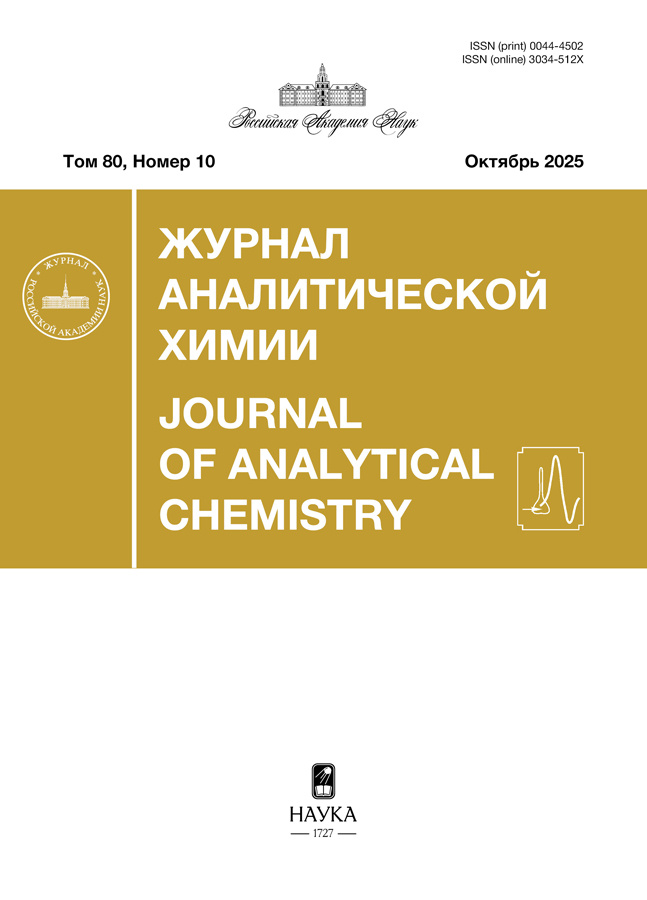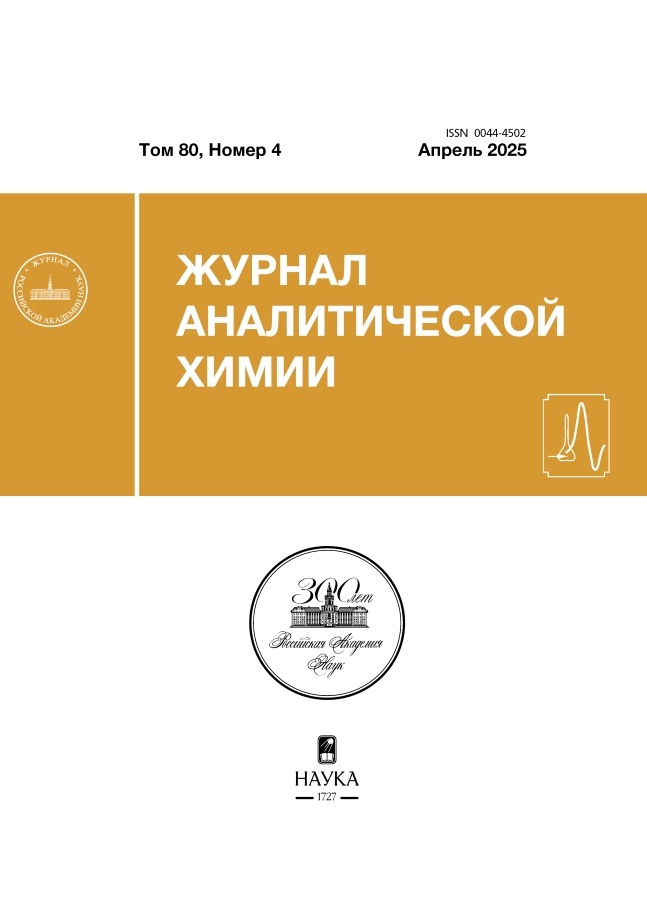Разделение и концентрирование биологически активных соединений методом капиллярного электрофореза с использованием модификаторов на основе имидазолиевого катиона
- Авторы: Ганиева А.Ш.1, Карцова Л.А.1
-
Учреждения:
- Санкт-Петербургский государственный университет
- Выпуск: Том 80, № 4 (2025)
- Страницы: 427-436
- Раздел: ОРИГИНАЛЬНЫЕ СТАТЬИ
- Статья получена: 05.06.2025
- URL: https://rjmseer.com/0044-4502/article/view/683049
- DOI: https://doi.org/10.31857/S0044450225040073
- EDN: https://elibrary.ru/aksfdl
- ID: 683049
Цитировать
Полный текст
Аннотация
Синтезировано катионное ковалентное покрытие стенок кварцевого капилляра на основе имидазолиевого катиона; воспроизводимость по электроосмотическому потоку (маркер диметилформамид) составила 99 %. На модельных системах фенил- и индолкарбоновых кислот (фенилмолочная, фенилянтарная, фенилбутановая, индолмолочная, индолпропионовая, индолакриловая гидроксиминдальная, гомогентизиновая, гомованилиновая, гидроксиндолуксусная кислоты) оптимизированы условия (концентрация и рН фонового электролита, природа и объем органической добавки) их разделения методом капиллярного электрофореза: 10 мМ фосфатный буферный раствор c рН 4.2 с добавкой 10 об. % ацетонитрила. Факторы разрешения соседних пар аналитов составили от 1.7 до 18.9. Показана возможность внутрикапиллярного концентрирования фенил- и индолкарбоновых кислот с применением синтезированного покрытия. Электростэкинг позволил сконцентрировать аналиты в 106–512 раз и снизить пределы обнаружения до 4–72 нг/мл.
Полный текст
Об авторах
А. Ш. Ганиева
Санкт-Петербургский государственный университет
Автор, ответственный за переписку.
Email: st110520@student.spbu.ru
Россия, Университетский просп., 26, Петродворец, Санкт-Петербург, 198504
Л. А. Карцова
Санкт-Петербургский государственный университет
Email: st110520@student.spbu.ru
Россия, Университетский просп., 26, Петродворец, Санкт-Петербург, 198504
Список литературы
- Карцова Л.А., Макеева Д.В., Бессонова Е.А. Современное состояние метода капиллярного электрофореза // Журн. аналит. химии. 2020. Т. 75. № 12. С. 1497. (Kartsova L., Makeeva D., Bessonova E. Current status of capillary electrophoresis // J. Anal. Chem. 2020. V. 75. № 12. P. 1497.)
- Kravchenko A., Kolobova E., Kartsova L. Multifunction covalent coatings for separation of amino acids, biogenic amines, steroid hormones, and ketoprofen enantiomers by capillary electrophoresis and capillary electrochromatography // Sep. Sci. Plus. 2020. V. 3. № 4. P. 102.
- Yang M., Lv W., Chen Y., Wu X., Gao J., Xiao J. et al. Chiral-induced covalent organic framework as novel chiral stationary phase for chiral separation using open-tubular capillary electrochromatography // J. Chromatogr. A. 2024. V. 1736. № 465334.
- Li X., Ma Q., Zheng X., Chen Q., Sun X. Recent applications and chiral separation development based on stationary phases in open tubular capillary electrochromatography (2019–2022) // J. Pharm. Anal. 2023. V. 13. № 4. P. 323.
- Bai Q., Zhang C., Zhao Y., Wang C., Maihemuti M., Sun C. et al. Evaluation of chiral separation based on bovine serum albumin–conjugated carbon nanotubes as stationary phase in capillary electrochromatography // Electrophoresis. 2020. V. 41. № 13-14. P. 1253.
- Kowalski P., Olędzka I., Plenis A., Roszkowska A., Bączek T. Strengths and weaknesses of ionic liquids as efficiency enhancers in capillary electrophoresis // TrAC, Trends Anal. Chem. 2023. V. 132. Article 117031.
- Chankvetadze B., Scriba G.K.E. Cyclodextrins as chiral selectors in capillary electrophoresis: Recent trends in mechanistic studies // TrAC, Trends Anal. Chem. 2023. V. 160. № 22. Article 116987.
- Tang W., Lu Y., Row K.H., Baeck S.H., Zhang Y., Sun G. Novel bovine serum album and β-cyclodextrin-based mixed chiral stationary phase for the enantioseparation in capillary electrochromatography // Microchem. J. 2022. V. 121. Article 107763.
- Kartsova L., Makeeva D., Davankov V. Nano-sized polymer and polymer-coated particles in electrokinetic separations // TrAC, Trends Anal. Chem. 2019. V. 120. Article 115656.
- Yun X., Wang L., Wang J. Enantioseparation of six profenoid drugs by capillary electrophoresis with bovine serum albumin-modified gold nanoparticles as quasi- stationary phases // J. Chromatogr. B. 2024. V. 1243. Article 124228.
- Fu Y., Li Z., Hu C., Li Q., Chen Z. In-situ immobilization of covalent organic frameworks as stationary phase for capillary electrochromatography // J. Chromatogr. A. 2023. V. 1705. Article 464205.
- He N., Li Z., Hu C., Chen Z. In situ synthesis of a spherical covalent organic framework as a stationary phase for capillary electrochromatography // J. Pharm. Anal. 2022. V. 12. № 4. P. 610.
- Ding W., Ma Du Y., Chen C., Ma X. Metal organic framework ZIF-90 modified with lactobionic acid for use in improved open tubular capillary electrochromatographic enantioseparation of five basic drugs // Microchim. Acta. 2020. V. 187. Article 651.
- Petr J., Maier V. Analysis of microorganisms by capillary electrophoresis // TrAC, Trends Anal. Chem. 2012. V. 31. P. 9.
- Hsu Ch.-N., Tain Y.-L. developmental programming and reprogramming of hypertension and kidney disease: Impact of tryptophan metabolism // Int. J. Mol. Sci. 2020. V. 21. № 22. P. 8705.
- Yun Y., Zhang Q., Zhao W., Ma T., Fan H., Bai L. et al. Relationship between the tryptophan-kynurenine pathway and painful physical symptoms in patients with major depressive disorder // J. Psychosom. Res. 2022. V. 163. Article 111069.
- Kolobova E., Kartsova L., Kravchenko A., Bessonova E. Imidazolium ionic liquids as dynamic and covalent modifiers of electrophoretic systems for determination of catecholamines // Talanta. 2018. V. 188. P. 183.
- Бессонова Е.А., Карцова Л.А. Методы on-line концентрирования в капиллярном электрофорезе / Проблемы аналитической химии. Т. 18. Капиллярный электрофорез / Под ред. Л.А. Карцовой. М.: Наука, 2014. С. 76.
Дополнительные файлы


















